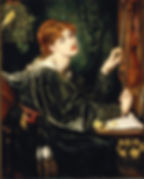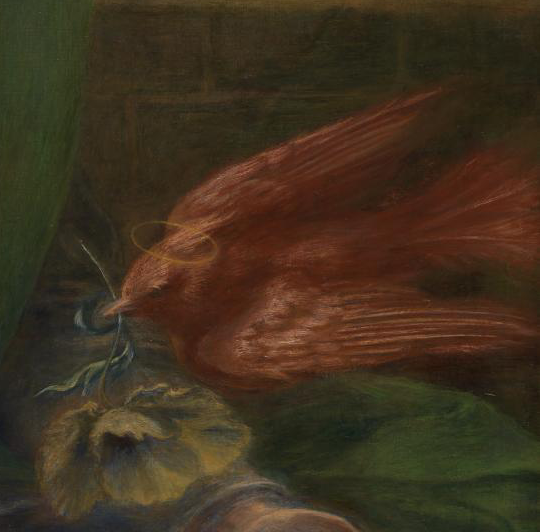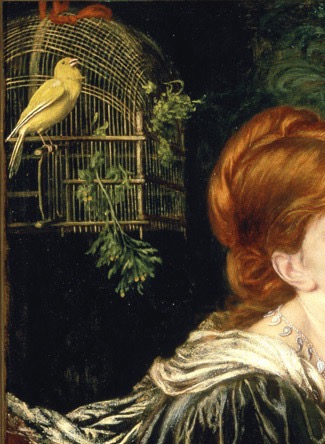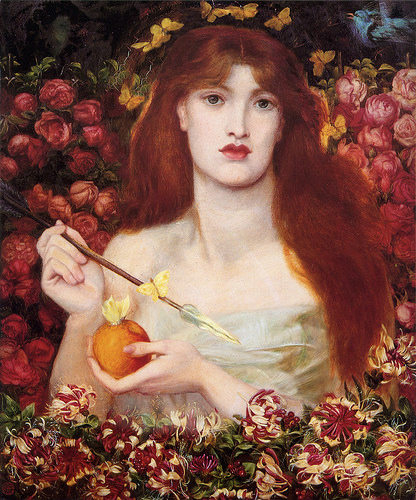Dante Gabriel Roestti - Muses & The Beau Monde
- Lilium
- Oct 14, 2020
- 6 min read


Gabriel Charles Dante Rossetti, born 12 May 1828, generally known as Dante Gabriel Rossetti, was an English poet, illustrator, painter and translator.
He founded the Pre-Raphaelite Brotherhood in 1848 with William Holman Hunt and John Everett Millais. Rossetti was later to be the main inspiration for a second generation of artists and writers influenced by the movement, most notably William Morris and Edward Burne-Jones.
I have always loved Rossetti's paintings, with their rich colours and intricate details they sing to my love of art history. For example in the painting Proserpine, everything from the square of light on her face to the ivy on the wall, it all has meaning. There are no accidents in Pre-Raphaelite art.
While many documentaries have been made about Rossetti, I have found that they turn the lives of the Pre-Raphaelites into a soap-opera or the decline and fall of celebrity, and only lucid attention is paid to the art and it's craftsmanship beyond the male gaze and possession of women. So I will glaze over it and focus on the beauty instead, sharing my favourite paintings of Rossetti and a selection of his poetry. I always find it wise when the lives of artists are turbulent, full of loss and sorrow, to show them respect and leave them to rest in peace.
So I shall tell you some details of his paintings, why those flowers and why those colours, the symbolism in the portraiture of Dante Gabriel Rossetti. We shall explore them a little together in what I hope is enough to make you want to dig deeper into the symbolism and meaning of all paintings.
"Beauty like hers is genius."
Dante Gabriel Rossetti

Proserpine
We begin with the same picture at the beginning of the article, Proserpine, painted in by Rossetti in 1874. According to classical myth, Proserpine, daughter of Ceres, was kidnapped by Hades and dragged down into the underworld to serve as his Empress. In the painting, however, there is no action, no plot. It is a quiet moment of grief, just a glimmer of light that intensifies her sorrow. Rossetti wrote about Proserpine:
'She is represented in a gloomy corridor of her palace, with the fatal fruit in her hand. As she passes, a gleam strikes on the wall behind her from some inlet suddenly opened, and admitting for a moment the sight of the upper world; and she glances furtively towards it, immersed in thought. The incense-burner stands beside her as the attribute of a goddess. The ivy branch in the background may be taken as a symbol of clinging memory.'
His Proserpine, like his model Jane Morris, is an exquisitely beautiful woman, with delicate facial features, slender hands, and flawlessly pale skin set off by her thick raven hair. Rossetti painted it at a time when his mental health was extremely precarious and his love for Jane Morris was at its most obsessive.
Rossetti began work on the painting in 1871 and painted at least eight separate versions, the last only completed in 1882, the year of his death. The painting we just discussed is the so-called seventh version commissioned by Frederick Richards Leyland, now at the Tate Gallery, with the very similar final version now at the Birmingham Museum and Art Gallery. The darkness and depth painted into the seventh version is definitely my favourite version.

Beata Beatrix
Rossetti started Beata Beatrix in 1863 after the death of his wife Elizabeth Siddal. The painting illustrates the last chapter of writer Dante Alighieri’s poem La Vita Nuova written in 1295. The female figure is of the writers’ beloved muse Beatrice Portinari and Rossetti portrayed her features after Siddal.
Rossetti ties the two love stories, one of Beatrice and Alighieri, and the other of Siddal and Rossetti, through symbolism, portraying their short and tragic marriage.
The dove, the standard symbol of love, appears as a messenger of death, dropping into her cupped hands a white poppy, which stands for sleep or death, perhaps also a reference to opium; Siddal had died as the result of a laudanum overdose.
Right above the dove is a sundial pointing at number nine associated with Beatrice’s death in La Vita Nuova, which occurred at nine o’clock on 9th June 1290. The moody light and hazy atmosphere create a halo-like aureole, and together with the expression on her face, hints at her ‘sudden spiritual transfiguration’, as quoted by Rossetti.

Behind the figure, a dim silhouette of a bridge disappears in a glowing light; this has often been identified as the Ponte Vecchio in Dante’s Florence. But it is vague enough to be doubled as Blackfriars bridge in London, next to which Siddal and Rossetti lived during their marriage. Finally, the two figures at the back, of Dante on the right, and of Love, symbolised by the colour red and holding a flame, on the left.

Veronica Veronese
Like much of Rossetti's work of the 1860s and 1870s, Veronica Veronese was inspired by Venetian painting. It is believed to represent “the artistic soul in the act of creation." A translation from the Rossetti Archive by Rowland Elzea:
'Suddenly leaning forward, the Lady Veronica rapidly wrote the first notes on the virgin page. Then she took the bow of her violin to make her dream reality; but before commencing to play the instrument hanging from her hand, she remained quiet a few moments, listening to the inspiring bird, while her left hand strayed over the strings searching for the supreme melody, still elusive. It was the marriage of the voices of nature and the soul—the dawn of a mystic creation.'
The symbolism in the painting includes the uncaged bird, which may represent "the marriage of the voices of nature and the soul" and overt flower symbolism. The camomile in the bird cage may represent “energy in adversity,” the primroses youth, and the daffodils reflection.
Jane Morris lent the green dress used in the pictures. The violin was part of Rossetti's collection of musical instruments, and the fan also appeared in another painting Monna Vanna. The few bars of musical composition on the manuscript may have been borrowed from George Boyce.

The Day Dream
Painted in 1880 with Jane Morris as the sitter and muse, the painting was initially to be called Monna Primavera, or Vanna Primavera, possibly inspired by La Vita Nuova, a narrative that captivated Rossetti and was the basis for earlier pieces of art.
The painting shows her sitting in the branches of a sycamore tree and holding a sprig of honeysuckle. This sweet-smelling climbing plant symbolised the bonds of love for the Victorians.
'The scene is a representation of a young woman in a green silk dress, shaded by the arabesque of the winged sycamore tree's leaves. Above her head and around her the tree branches are depicted almost embracing her, or as if she was emerging from the tree itself, almost as a dryad, or tree nymph.'
'She is portrayed clad all in green, her dress is a romantic wide and loose silk robe, flowing in graceful folds down, blending in with the tree's leaves, that connects the subject and its surroundings visually. She is immersed in her day dreams, turning her gaze downwards, away, towards something unseen or perhaps only perceived by her. The depiction of the young, elegant woman in her shelter surrounded by the branches, is adding to the secretive feeling of the painting, maybe indicating the furtiveness of the affair or a clandestine meeting place. In the shelter it is dark, but around her shoulder there is light, light blue compartments against a dark green background, signalling that it is daytime.'
Rossetti was also a poet, and the title relates to his poem of the same name, the sonnet reads:
The thronged boughs of the shadowy sycamore
Still bear young leaflets half the summer through;
From when the robin 'gainst the unhidden blue
Perched dark, till now, deep in the leafy core,
The embowered throstle's urgent wood-notes soar
Through summer silence. Still the leaves come new;
Yet never rosy-sheathed as those which drew
Their spiral tongues from spring-buds heretofore.
Within the branching shade of Reverie
Dreams even may spring till autumn; yet none be
Like woman's budding day-dream spirit-fann'd.
Lo! tow'rd deep skies, not deeper than her look,
She dreams; till now on her forgotten book
Drops the forgotten blossom from her hand.
The chalk sketch that Rossetti drew in 1878 that The Day Dream was based on, is now held at the Ashmolean Museum in Oxford, shows a different blossom in her hand. A white convolvulus which in the Victorian language of flowers, like the honeysuckle, means 'bonds'.





















































































































